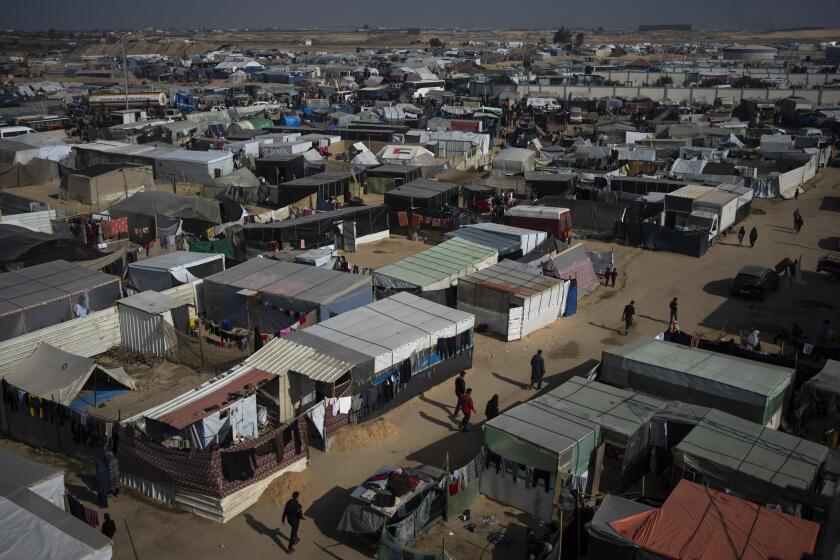Allies Give Arabs High-Profile Role : Strategy: The coalition hopes to dispel notion that the conflict is between Western ‘infidels’ and Muslims.
The television images from the front lines were filled with America’s Arab allies in action.
Machine gun-toting Saudis fired into Iraqi bunkers and stood guard over Iraqi prisoners. Excited Egyptians loaded shells and fired artillery from forward desert embankments. Kuwaiti resistance forces were reported to be taking up posts on the outskirts of Kuwait city.
The high profile given the Arab forces on the first day of the ground war reflected a carefully calculated effort by coalition commanders to show that the Saudis, Kuwaitis, Egyptians and others are full-fledged participants in ousting Iraq from Kuwait.
Coalition strategists are hoping to dispel the impression among Arabs that the war pits Western “infidels” against Muslims. They also want to bolster the self-esteem of Arab troops, who were the subject of open doubts before the war about how well they could fight.
At the same time, U.S. officials are seeking to counter the widely held notion in the United States that America’s allies are not carrying their share of the combat burden.
“I want to emphasize this is a coalition effort,” Gen. H. Norman Schwarzkopf, commander of the U.S. forces in the Gulf, took pains to emphasize during a brief appearance before reporters in Riyadh on Sunday.
The countries participating, so far, are the United States, Saudi Arabia, United Kingdom, France, United Arab Emirates, Bahrain, Qatar, Oman, Egypt, Syria and Kuwait, he said, taking care not to leave any country out.
Also, political analysts say that as the coalition retakes ground in Kuwait, the visible role of Arab troops in the coalition is expected to grow--including giving Arab troops the lead in the symbolically important liberation of Kuwait city.
“We want to give the Kuwaitis the chance to enter Kuwait city first,” Prince Bandar ibn Sultan, the Saudi Arabian ambassador to the United States, said in an interview.
In addition, after Kuwait’s liberation, the allies plan to use the most disciplined of Kuwaiti and Saudi troops to prevent Kuwaiti Bedouins from seeking violent revenge against the Iraqi forces who ravaged their country, an Arab source said.
Such tactics are not unique to the Persian Gulf War. At the climax of World War II, U.S. Gen. Dwight D. Eisenhower held American forces back so that Soviet forces could enter Berlin first, partly to avenge the Nazi siege of Leningrad earlier.
And allied commanders permitted exiled French Gen. Charles de Gaulle to stage a triumphant return to Paris at the end of that war, even though De Gaulle had not taken any part in the battles leading to the liberation of the French capital.
But the current strategy is broader, in part to appeal to Arab sensitivities. In general, “we want to minimize, if possible, soldier-to-soldier contact between the non-Arabs and the Iraqis,” Bandar said.
Daniel Pipes, director of the Foreign Policy Institute in Philadelphia, said such tactics could help defuse the worldwide perception that Iraqi President Saddam Hussein is Islam’s champion--even though the Saudis have been portrayed as the guardian of Islam for decades.
The strategy is reminiscent of that used by British officer T. E. Lawrence--renowned as “Lawrence of Arabia”--who marched a band of Arab guerrilla forces into Damascus, Syria, ahead of regular British units in an attempt to rout the Turks from that city in 1918.
“Then, as now, it was Muslim against Muslim, with the great Western power on one side but not wanting to be too overbearing about it,” said Pipes. “They did this by letting the militarily less powerful Arab ally take the most prominent roles.”
Loren Thompson, deputy director of National Security Studies at Georgetown University, said the aim is obvious. “The coalition is attempting to make this look like a real coalition, and not just a group of allied powers imposing peace on the Middle East,” he said.
In fact, 27 nations besides the United States are participating in the coalition. Washington has sent more than 500,000 troops and the others have deployed thousands more--including 40,000 Egyptians, 15,000 Syrians and 10,000 from Bahrain, Oman, United Arab Emirates and Qatar.
After Iraq’s Aug. 2 invasion of Kuwait, 4,500 Kuwaiti army personnel escaped with about 35 Chieftain and Vickers Mark 1 battle tanks. Another 7,000 Kuwaiti volunteers were subsequently trained and equipped for combat.
But the effort also poses some risks. Having a wide variety of forces on the same battlefield can strain communication and coordination and increases the dangers of confusion and incidents of “friendly fire.”
Such dangers are particularly acute among the Arab forces, many of which use Soviet equipment. Syrians and Iraqis, for example, use Soviet-made T-72 tanks; the Egyptians and Iraqis employ the same kind of armored personnel carriers.
Still, the allies have had months to prepare a coordinated offensive, and many of the countries had previous security relationships on which to build, said Barry Posen, a political science professor at the Massachusetts Institute of Technology defense studies program.
Even before the current Gulf crisis, Americans had been training with Egyptians, the British had practiced with Kuwaitis and the Saudis had worked with some of their smaller Gulf neighbors.
“The allies have such an overwhelming edge in many ways on the battlefield that they can afford to be flexible” in giving Arab forces prominent front-line roles, said Pipes. “This is not a matter of having to worry about winning.”
More to Read
Sign up for Essential California
The most important California stories and recommendations in your inbox every morning.
You may occasionally receive promotional content from the Los Angeles Times.






